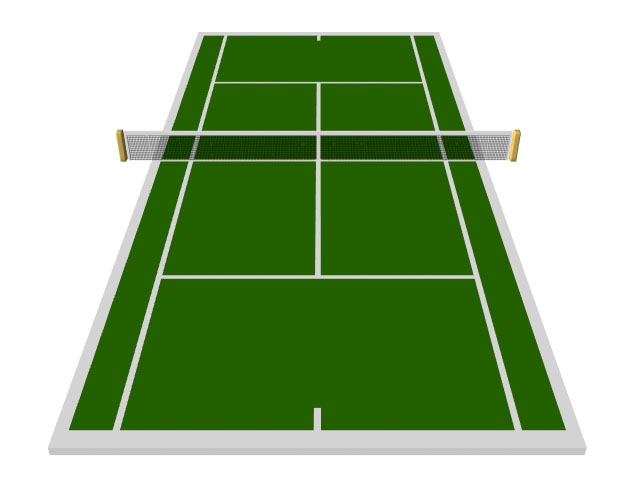
The Tennis Court
A tennis court is a rectangle, with lines that mark the outside boundaries of the court. These are called the sidelines and baselines. Two smaller rectangles, inside the larger rectangle, mark the service boxes. The player's first hit (serve) must cross the net and bounce within the smaller rectangle to start the point. Boundaries for doubles (2 players against 2 other players) are called "doubles alleys". These boundaries (or baselines) are wider than the boundaries for two singles players.
The size of the rectangular court for singles is 78 feet long and 27 feet wide. The doubles alleys add 4 and 1/2 feet to the width on each side. The service line runs parallel to the baseline and is 21 feet from the net. The service center line runs down the middle of the court from the net to the service line. This makes two equal service boxes 21 feet long and 13 and 1/2 feet wide.
The net is in the middle of the court, halfway between the two baselines. The net is 3 feet high at the center of the court. The net must be 3 and 1/2 feet high at the singles sidelines or at the doubles sidelines or alleys.
To begin each point the server has two chances to serve into one of the service boxes. After the serve, the players must hit (return) the ball over the net. The ball must stay within the boundaries of the court (baseline and sidelines) for singles or doubles.
Although the dimensions of all tennis courts are the same, tennis court surfaces vary dramatically. One of the unusual things about professional tennis is that major championships and other pro events are played on different surfaces that cause the ball to bounce very differently.
There are four major types of court surfaces. The first is hardcourt, which is asphalt or sometimes concrete, covered with colored acrylic paint mixed with sand for texture. These are far and away the most common courts in the United States, especially in the West and in California. The U.S. Open in New York is played on a hardcourt surface.
The second surface is grass, which is similar to a golf putting green. These courts are quite rare, existing at a few private clubs. However, grass is a very important surface at the pro level. Probably the most famous and historic tennis tournament is Wimbledon (England), which is played on grass courts.
The third is red clay. This surface is made of crushed brick that is packed to make the court, then covered with a loose "topping" of additional crushed particles. This surface is the most common in Europe and South America. The French Open in Paris is played on this surface.
The fourth surface is green clay. This surface is similar to red clay. A naturally occurring green clay is packed to make the subsurface, then covered with topping. These clay courts are found in large numbers in the Eastern and Southern parts of the United States.
In general, hardcourts and grass courts are considered to play "fast". While red and green clay courts are considered "slow". On the faster courts the bounce of the ball is lower, usually somewhere between the waist and the knees. In clay courts the ball can bounce to shoulder height or higher.
Some players will do better on one surface than another. Players with larger, looping swings, that produce heavy topspin, may have better success on clay. They tend to play more from the backcourt. On faster courts, players with more compact, classical strokes usually have the advantage. They tend to go to the net much more, especially on grass. They also stand in closer to the baseline during rallies, often hitting the ball as it rises off the bounce.
The footing is very different on the loose surface topping of clay courts, compared to grass or hardcourt. Players learn to slide into many shots on clay because of the loose surface. On hardcourt or grass the player can stop, and set up to hit in a relatively still position.